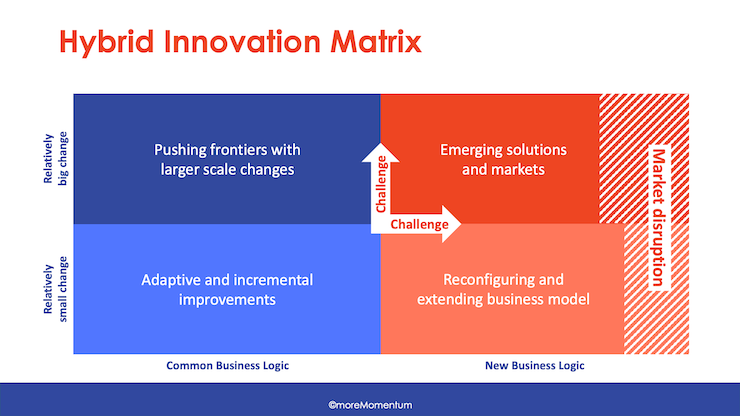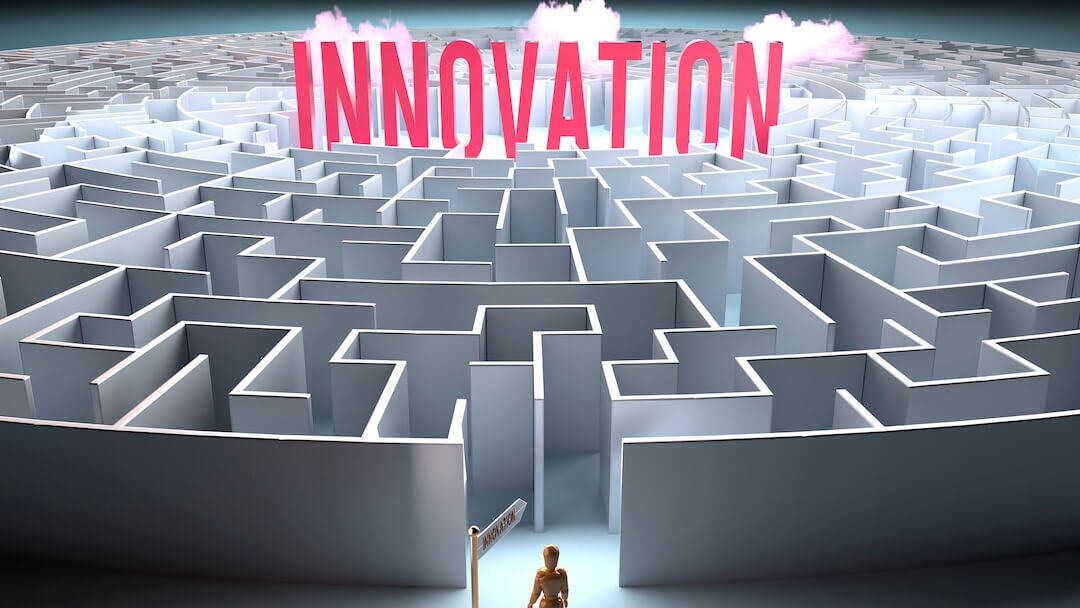Different types of innovation require different strategies to succeed. But there is no single silver bullet. We need frameworks and guidelines to define a good strategy. The Hybrid Innovation Matrix is a practical framework to help establish your strategy for developing your digital services.
Download as pdf
Introduction
Many have unclear and inadequate strategies for developing their digital services, causing crucial initiatives to fail. Manufacturers who are too slow in developing their digital services will fall behind the (new) competition and struggle with increasing pressure on their revenue and margins.
Innovating and growing digital services is challenging. We need more than anecdotal success stories. We need frameworks and guidelines for clarity and logic to define adequate strategies and to accelerate the growth of digital services and be one of the winners during disruption and post-covid.
Below I will describe the Hybrid Innovation Matrix, one of such frameworks that help strategising digital services innovation.
In this article:

The Problem
Digital transformation and digital services are increasingly hot topics. Still, many manufacturers are stuck with their digital strategies and digital innovation strategies. Often, they experience a few of the following:
- Being unclear about the business objectives and how this will generate value for the business.
- Not having a clear vision of how the company’s business model will evolve.
- Political discussions amongst senior stakeholders about vision, strategy, priorities, investments and ownership of the digital innovation.
- Fearing the new risks from uncertainty of the initiatives and unpredictability of the outside change.
- Sacrificing longer-term initiatives for short-term initiatives and low-hanging fruit.
- A bias towards business-as-usual and missing valuable opportunities beyond business-as-usual.
This is pretty frustrating for those who have great ideas and are working hard on innovative ideas.
Poor innovation strategies
Here is the problem
Many leaders of manufacturing companies:
- Are not clear enough about what they are - and should be - aiming for with digital services.
- Do not have a balanced portfolio of different types of innovation.
- Do not recognise the different challenges and obstacles typically related to different types of innovation and in the different phases of an innovation.
- Therefore, often apply inadequate approaches, techniques and strategies to drive digital services innovation.
Innovating and growing digital services is challenging. We need more than anecdotal success stories. We need frameworks and guidelines for clarity and logic to define adequate strategies and to accelerate the growth of digital services and be one of the winners during disruption and post-covid.
There is a lot at stake
Manufacturers who are not able to accelerate the growth of their digital services run the risk of falling behind competition and the new – digital savvy – entrants in their industries. They risk having a slower pace of change than the pace of change in their industry and market. This is a bad position to survive and thrive during the digital disruption of today.
Apply different strategies for different types of innovation
The Hybrid Innovation Matrix is an effective and practical framework to get clarity on your strategic options for digital services and other innovation domains. This matrix focuses on recognising the various challenges, obstacles, and critical success factors for the different types of innovation to help you defining your portfolio and strategy for digital services.
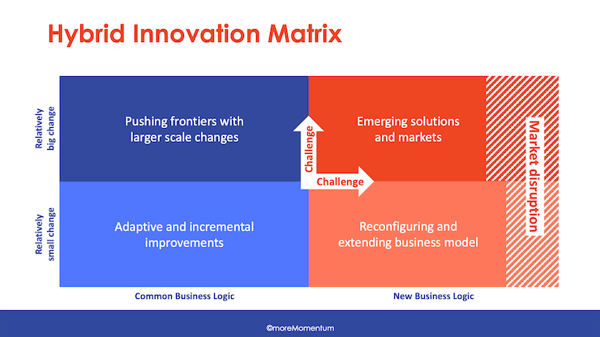
A brief and general description of the matrix before diving into the different quadrants:
- We differentiate innovations within the existing business logic from those developing new business logic along the horizontal axis. There is a prevailing business logic in every industry and business - a set of common patterns, knowledge, experience, and frameworks of thinking. We use this logic to understand our environment and make decisions. This common business logic defines how we usually act, learn and change.
- Along the vertical axis, we have the relative size of the innovation or change. In the left column, we differentiate incremental improvements from the more radical innovations that push the boundaries. We differentiate reconfiguring and extending an existing business model from developing entirely new solutions and markets with entirely new business models in the right column.
Adaptive and incremental improvements
Adaptive and incremental improvements is all about improving the performance of existing products, services and operations in incremental steps. All departments, teams and individuals have a role to continuously drive improvement based on any feedback and deviations from expectations. Typically, these interventions use approaches like PDCA (Plan-Do-Check-Act).
Although data and other digital capabilities play an important role, I do not consider this digital services innovation. However, I will shortly mention some typical objectives, challenges, and strategies to help differentiate this from other innovation types.
Objectives
Continuously improve and stay up-to-date with:
- Products and services.
- Customer experience.
- Cost and waste.
-
Challenges
- Activating all knowledge and insights on how to improve.
- Engaging everyone to improve continuously.
- Alignment and coherence.
Strategies
- Ownership across organisation and functional departments (R&D, marketing, service).
- Systematic tools, processes and methods for development (scrum, kaizen, value analysis, stage-gate, customer feedback, root-cause analysis).
- Basic project management methods.
Pushing the frontiers
Pushing frontiers is about more significant innovations within the common business logic.
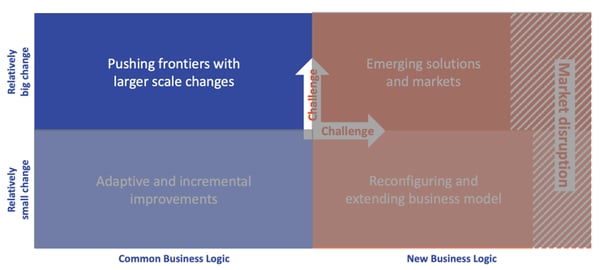
In every industry, you have common pathways of how the performance of products, services and operations develop and how (latent) customer demands evolve. New digital technologies play a significant role: they enable bigger changes and trigger bigger changes.
Miscellaneous examples
- Rapidly evolving technology of semiconductors.
- Hybrid and electric transmission of vehicles.
- Digital optimisation of processes industry.
- Predictive sales of consumables.
Examples in services
In services, pushing the frontiers is currently the most prevailing topic and focus for digital services. Examples are:
- Predictive maintenance.
- Remote diagnostics.
- AI-driven scheduling.
- Data-driven maintenance engineering.
- The common business logic is that we need to continuously improve customer value, productivity and efficiency with existing services that offer clients good condition and equipment uptime.
Objectives
- Protect and sustain your current business by staying up-to-date.
- Potentially establish a competitive advantage by:
- Being the first to benefit from trends, before competitors follow.
- Find a break-through innovation which is hard for competitors to copy on the short term.
These innovations seldomly result in the growth of revenues and margins as they do not expand the addressable market, and most competitors are doing the same thing. Productivity and efficiency improvements therefore lead, most of the time, to lower prices for clients instead of more service sales or higher prices.
Challenges
Initiatives to push the frontiers require a significant upfront investment in technology, infrastructure and new capabilities. The return on investment is not sure and takes considerable time.
Overall challenges:
- Finding and developing broad strategic knowledge.
- Pursuing latent opportunities.
- Preventing too narrow focus (for example only on products).
- Mitigating calculated risks.
- Timing of cross-functional involvement.
- Preventing political battles.
Challenges during the discovery and ideation phase:
- Bringing digital, technical and service expertise together. Too often the central digital departments own the digital development, and they lack the service expertise and focus.
- Dedication and ownership to drive the performance of services and operations and find big opportunities.
- Finding strategic expertise inside and outside the company.
- Avoiding a too narrow focus on technology or efficiency only.
- Having a deep understanding of (latent) customer needs.
- Finding break-through applications of the new digital technologies beyond the usual suspects.
Challenges during the decision-making phase:
- Managing the risks of uncertain outcome while requiring high upfront investments.
- Narrow focus of decision-makers, with limited understanding and focus of services and digital.
- Increasing knowledge gaps between various decision-makers – those who have investigated and those who haven’t.
- Political battles or polarised discussions due to:
- Lack of adequate data for objective decisions.
- Uncertainty of outcome.
- Conflict of interest due to target setting, silos and incentive schemes.
- Lack of new expertise, which is only with the experts.
- Lack of strategic alignment and shared concern.
Challenges during the development and implementation phase:
- Implementation and change management skills and focus.
- Required expertise and knowledge throughout the organisation.
- Digital and service mindset throughout the organisation.
- Resources in the operating organisation.
- Conflict of interest due to target setting, silos and incentive schemes.
- Secure productivity improvements (often, potential cost savings evaporate by new inefficiencies).
- Struggle to measure the impact of the innovation in the performance.
Good strategies
The name of the game here is managing a wider portfolio, including higher risk projects.
Good strategies overall:
- Establish a clear and compelling direction in which the company is heading and how it relates to the industry and market developments.
- Establish stretched targets and ownership for the results.
- Build a shared concern on developments in the industry and the importance of adapting to it.
- Establish cross-functional and dedicated teams of experts for specific initiatives.
- Have owners of the stretched goals taking ownership of the innovation projects.
- Establish heavy weight dedicated project management.
Good strategies during the discovery and ideation phase:
- Use advanced techniques for finding (latent) opportunities, such as design-thinking and empathic design.
- Involve external experts (consultants and new partners).
- Allow the project teams to explore and experiment to find break-through technologies and/or applications of emerging technologies.
Good strategies during the decision-making phase:
- Bring decision-making to the strategic level.
- Maintain a balanced portfolio of innovations for different areas, like products, services, digital technologies, commercial.
- Apply a stage-gate and review process, with clear criteria for deciding which initiatives to continue to the next stage and which to terminate.
- Educate stakeholders on the decision level on the new critical insights and knowledge that was acquired by the project teams.
- Invest in further research first.
- Develop a business case, backed by reliable information.
- Use advanced risk-assessment techniques.
Good strategies during the development and implementation phase:
- Agile development techniques.
- Co-development with your best clients.
- Early involvement of stakeholders from various functions.
- Develop digital and service mindsets.
Reconfiguring and extending business model
Reconfiguring and extending the business model involves fundamental shifts in one or more of the following:
- Entering new markets.
- Solving other customer problems with new kinds of offerings.
- Solving customer problems differently, leaping forward with cost levels and accessibility of the offering.
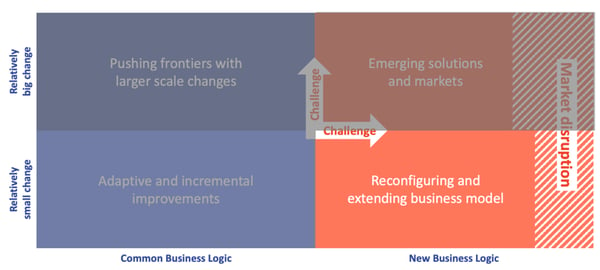
These innovations require other perspectives and business logic than those which are currently dominant in a business and industry.
Miscellaneous examples
- Low-cost airlines with a new value proposition and new operating models.
- Manufacturers selling directly to the end-clients instead of through wholesale or retail (like Dell and Tesla).
- Books being sold online.
- Taking a cab via an app.
Examples in services
- Product-as-a-service offerings, like for example:
- Storage solutions moving to cloud services.
- Pay-per-use offerings like aircraft engines and mining vehicles.
- Fleet management services, for example, for construction tools.
- Providing operational services:
- Process performance data.
- Real-time operational optimisation.
- Process consulting.
- Managed service, like a manufacturer of kidney dialysis equipment now operating entire dialysis centres in hospitals, instead of selling equipment to hospitals.
- Simplifying and de-skilling equipment maintenance (through automated monitoring, diagnostics, resolution, and swapping components) allowing non-technical staff, users or even couriers to do the job.
Objectives
- Generate new revenue streams from existing clients.
- Generate new revenue streams from new markets.
- Increase strategic differentiation.
- Anticipate potential (low cost) disruptions.
Challenges
Developing and launching new value propositions and business models requires a wider and peripheral vision to escape from the established dominant business logic.
Overall challenges:
- Unbounded discovery of trends, weak signals and opportunities.
- Pursuing opportunities with unknown, unpredictable and uncertain elements and limited evidence.
- Mitigating “conflict” with mainstream operations and research.
Challenges in the discovery and ideation phase:
- Being open to new knowledge, patterns, ideas and opportunities without being pulled back into ‘business- as-usual’ by many forces such as colleagues, clients, vendors, service suppliers and investors.
- Forming new coalitions or partnerships outside the current ecosystem.
- Recognising weak signals of potential trends, threats and opportunities, and when these become emergent.
- Mitigating “conflict” with mainstream research activities.
- Understanding and recognising potential market disruption from immature and emerging alternatives (often at the market's low end).
Challenges in the decision-making phase:
- Having a clear and transformative vision for the organisation, value propositions and business model.
- Limited knowledge and uncertainty about unpredictable developments.
- Battles between stakeholders in operating organisation and innovation organisation.
- Stopping initiatives because of lack of short-term results, favouring initiatives closer to 'business-as-usual' with quicker results.
- Not considering weak signals for potential threats, like market disruption.
- Fear of cannibalism.
Challenges in the development and implementation phase:
- Embedding new knowledge throughout the organisation.
- Building new mindsets and competencies.
- Mitigating “conflict” with mainstream operations.
- New innovations being killed by too early integration into the existing business model.
- Existing clients may not like the new solutions (yet).
- Finding the early business cases for early cashflow to (partially) fund the investments.
- Scaling the new offering or solution beyond the early adopters (the first 13,5% of your client base).
Strategies
The name of the game here is running entrepreneurial satellite teams.
Good strategies overall:
- Add a transformative direction of the company, which is relatively open.
- Build a shared concern for developing business models for the next growth curves.
- Have autonomous entrepreneurial and multi-disciplinary teams, decoupled from the mainstream organisation. The more the new venture is radically different from today’s core business, the more distant these satellite teams should be.
- Allow addressing other markets or segments for (first) success than the core business.
- Build and maintain a portfolio of innovations, as only a few will have some success, and even less will have a break-through success.
Good strategies during the discovery and ideation phase:
- Less targeted search assignments (compared to “pushing the frontiers”).
- Techniques to reframe and think out-of-the-box.
- Build new and broad expertise networks outside your industry.
- Experiment and learn.
- External contracting or outsourcing.
- Scouting for successful initiatives in the market.
- Develop scenarios around weak signals.
Good strategies during the decision-making phase:
- Reframing of the opportunities and threats.
- Decentralise decision-making on the selection of initiatives and options to the entrepreneurial teams.
- Base go/no-go decisions on vision and scenarios, not on business cases and early (financial) results.
- Rapid prototyping.
- Acquire early success ventures in the market.
- Allow competing initiatives to be pursued.
- Allow initiatives to (potentially) compete with today’s core business. You’d best embrace cannibalism of your products and services to thrive.
Good strategies during the development and implementation phases:
- Keep the new business in entrepreneurial satellite teams. Avoid too early integration of radically different business models into the existing business, as this will probably kill the innovation.
- Lean start-up and agile development teams.
- Co-creation with the most interesting (potential) clients.
- When the initiative gets good tracking and is rapidly growing, carefully consider synergies and conflicts and decided whether to:
- Keep as a separate business unit and let it grow.
- Integrate into the existing business as an add-on.
- Pivot or transform the existing business into this new business model.
- De-invest the venture.

Emerging solutions and markets
Emerging solutions and markets is about the radically new emerging solutions which solve unmet (latent) needs or unsolved problems.
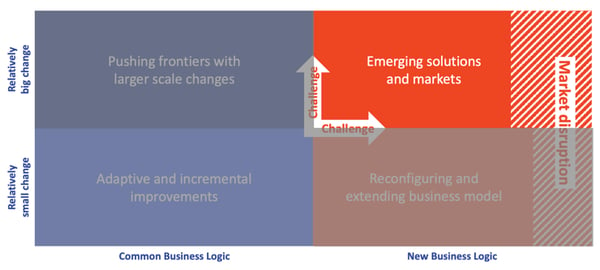
For these innovations, radically new technologies and perspective are being developed and applied in ways not seen before. These seldomly come from one company, but are created by large ecosystems of companies, research organisations, academics and governments, developing different elements or alternatives of the emerging solution.
In the early stages, we typically see many different ideas, principles and solutions popping up while it is still unclear which of the competing alternatives will emerge and become the dominant solution.
Miscellaneous examples
- Renewable energy is an interesting example of today. We have a global problem with fossil energy sources and the impact on our climate. New solutions for primary energy sources (like solar and wind) and intermediate sources for transport and storage (battery, fuel cell, nitro-hydrogen) are in development. Most are not mature enough yet to become mainstream.
- Google Maps rapidly pushing away navigation devices.
- PC’s displacing minicomputers.
- Smartphones, email.
- Digital photography displacing analogue photography.
Examples in services
- Data-driven healthcare, where we see various data driven and mobile solutions emerging to have healthier lifestyles, remotely monitor biometrics and diagnose deceases much earlier.
- Car-sharing of autonomous driving cars.
- Airbnb opening up the market of renting private homes at a lower price.
- Music services like Spotify and iTunes replacing vinyl and CDs.
Objectives
- Anticipate for new trends which can make (part) of your business obsolete.
- For companies that are - or soon will be - in very mature, declining and consolidating markets, these innovations could generate a new business for the next growth trajectory. Be aware, most often, this will take a couple of years, if not more.
Challenges
The main challenges:
- Building and working in multiple new networks in emerging domains.
- Handling fuzzy and emerging knowledge.
- Let go of strategic planning routines.
- Managing complexity.
- Managing the unknown and unpredictable.
Strategies
The name of the game here is to be at the front where emerging solutions are being co-evolved and become dominant.
- Have multiple satellite structures with other companies, research organisations and academics outside the company and industry.
- Participate in new and diverse networks.
- Work with crowdsourcing, open innovation, netnograph (Wikipedia) and the like.
- Drive high-pace improvisation, probing and learning, gradually focussing more on the emergent innovation.
- Find early-stage, light-weight business cases to be able to afford multiple - parallel - business models.
Maintain a diverse portfolio of innovations
Companies that have been successful for a long time, continuously adapt to new developments and were able to turn potentially threatening trends into opportunities, are the ones which have a focussed and well-balanced innovation strategy and portfolio.
They:
- Continuously have several initiatives in each quadrant of the Hybrid Innovation Matrix.
- They actively search for initiatives for each quadrant and ensure in each quadrant new innovation make progress.
- Have dedicated budgets for each quadrant, often ring-fenced budgets.
- Are aware of the different challenges of each innovation and apply the adequate resources and strategies for each.
Resource allocation to all quadrants
Maintaining a solid portfolio of innovations is allocating adequate resources and choosing which initiatives to give priority over others.
A common pitfall is that growth initiatives (less tangible, more uncertainty, lack of data for a solid business case, unknown to the business so far) tend to be on the back burner to prioritise short-term improvement projects. The result is that essential growth initiatives never come to life.
A good practice is:
- Allocate fixed percentage of the total revenue to R&D and innovation.
- Distribute fixed portions over the 4 quadrants.
- Map each innovation to the appropriate quadrant.
- Let each innovation only compete for resources with other initiatives in the same quadrant.
There is no silver bullet for the total R&D and innovation budget and how to distribute this over the 4 quadrants.
In a relatively stable manufacturing or industrial sector with not too many significant shifts in technology, a good average seems to be:
- 1-5% of the revenue allocated for R&D and innovation.
- 70% of the R&D and innovation budget for adaptive and incremental improvements.
- 20% of the R&D and innovation budget for pushing the frontiers and enhancing the business model.
- 10% of the R&D and innovation budget for emerging solutions and markets.
In sectors with significant technological developments (like healthcare, energy, mobility) and sectors which will see a big impact from digital technologies, we typically see:
- Higher budgets for R&D and innovation as a portion of the revenue.
- Higher portion of this budget being allocated to:
- Pushing the frontiers.
- Enhancing the business model.
- Emerging solutions and markets.
- And indeed, less budgets for adaptive and incremental improvements.
It is hard to find more insights about best practices and benchmarks of how innovation budgets are structured and allocated to digital development. That is why we are working on a benchmark of digital services innovation.
Conclusion
For manufacturing companies, improving innovation capabilities and growing digital services and solutions is critical for their near term and longer-term success.
The Hybrid Innovation Matrix can help in:
- Getting clarity on the options when developing your innovation strategy.
- Building a strategic alignment and shared concern with senior stakeholders.
- Developing and maintaining a healthy innovation portfolio.
I’d recommend you mapping all your digital and service initiatives on the Hybrid Innovation Matrix. Maybe make two versions: the current state and the desired state.
Is your innovation portfolio fit to thrive during the digital disruption?
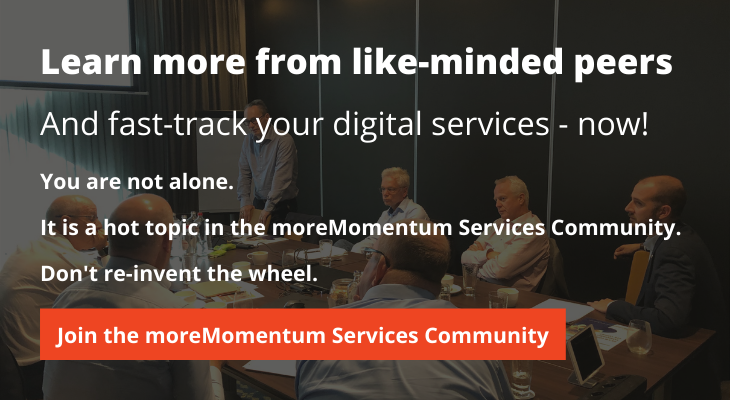
Jan van Veen
Jan 23, 2021 6:19:03 PM
